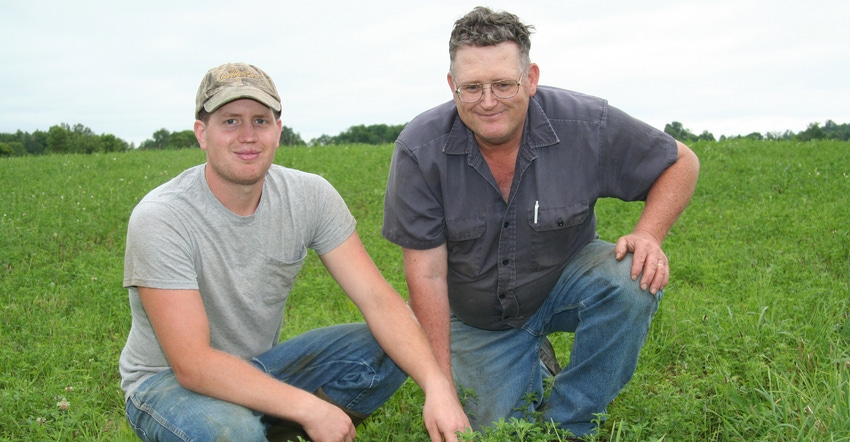
John D. Peck always had reservations about the Margin Protection Program. But the long downturn in milk prices finally forced his hand. Last year, he decided to sign up.
“It’s definitely not been a fun five years,” Peck says. “2014 was OK. Since then it’s been a downward spiral.”
Peck signed up for the program at his local ag service office. What he didn’t expect, though, was that changes he had made to improve milk production wouldn’t count toward his production history.
MPP-Dairy, which was approved in the 2014 Farm Bill and replaced the previous Dairy Price Support and Milk Income Loss Contract programs, used a farm’s highest production year from 2011-13. Peck says that in those three years his highest average production was 2012, when his cows produced 857,000 pounds.
In 2014, Peck, with help from the New York Farm Viability Institute, formed a dairy profit team to help improve efficiency and increase production. American Agriculturist featured Peck’s story three years ago.
“My goal was to reach a 65-pound average,” he said at the time. “But that wasn’t attainable without a feeding program including corn silage fed in a mix with haylage, pasture, round bales and grain.”
He planted corn for the first time, which he said improved his cows’ condition and production even in winter.
The changes worked. Peck says his production jumped to 1.2 million pounds. He has 105 cows and has 280 tillable acres.
The new Dairy Margin Coverage program, which was approved in the 2018 Farm Bill and just opened for signups on June 17, has been lauded by government and dairy industry officials as a much-improved version of MPP. The new program enables farmers to cover more of their milk at higher margin levels and allows farmers to dabble in other risk management programs at the same time, not just one or the other.
But the program left one key element in place from MPP: If a dairy farmer had previously enrolled in MPP, which Peck did, they must use their production history from that program; there is no reset.
Frustrated and flabbergasted
“I am completely flabbergasted and disgruntled with the dairy lobby that either missed the boat and just rolled right over and let it happen," he says. “This is just a repackaging … of the same garbage.”
Peck says that he’s looked at other options, including the Dairy Revenue Protection program — this focuses more on quarterly milk prices rather than margins — as well as LGM-Dairy, a Farm Service Agency program that provides protection when feed costs rise or milk prices drop. But neither program, Peck says, works for his situation, and the costs are too high.
“I don't really have great options to actively try to hedge milk. There is nothing offered by my co-op (Jefferson Bulk Milk Co-op)," he says. “I’m just running the risks of the highs and lows at this point.”
Bottom line, Peck thinks he should be able to cover more of his milk, much of which came from improvements he made in his feed ration.
"All that gain is nonexistent because I didn't pay to play to get my little 2% bump," he says, referring to annual adjustments to MPP production history based on the national average milk production. “The only good thing was raising up the upper limit, but you're still left with a catastrophic floor that isn't enough. This is completely the wrong way to be doing a commodity program like this.”
All in the statute
Alan Bjerga, senior vice president of communications at The National Milk Producers Federation, says the issue with production history is not something that can simply be fixed by changing a rule.
“This isn’t a situation that can be fixed through rules, you have to change the statute to change the years. We are certainly open to supporting legislation to change the statute if it were introduced, but it’s also important to note that this debate was part of farm bill discussion, and the intent of lawmakers was to use 2011-2013 as the basis,” Bjerga says.
The federation’s focus, he says, is on enacting the program as it is currently written.
“We at NMPF are with the department to resolve implementation issues that have arisen as the law has been put into place, such as situations where producers expanded due to intergenerational transfers or other unique situations where rules may have some more flexibility,” he says. “We’re also pleased that, under the new law, farmers can cover 95% of their production history, compared to 90% under the previous farm bill. But on the question of basis years, a broader update is not permissible as the law requires the use of the highest year of 2011-13 to calculate production history.”
Taking action
Peck says that his only option at this point is to raise the issue with his local representatives.
Recently, he spoke to Rep. Elise Stefanik, R-Albany, on getting legislation introduced to get the statute changed.
He also supports a revamp of the federal milk marketing system, which he says doesn’t reflect consumer demand for products.
“It’s got to reflect the current situation,” he says.
About the Author(s)
You May Also Like






